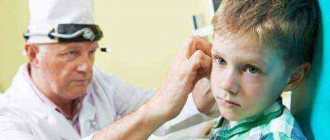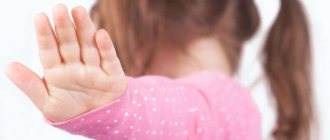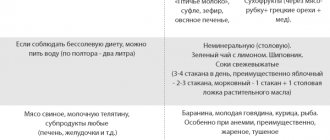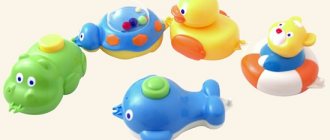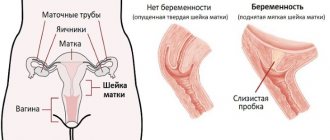If a child experiences neck pain, in many cases the symptoms may indicate serious problems. It is very important for parents to pay attention to the slightest complaints. It is important to consult a doctor in time to avoid irreversible consequences. A pediatrician will examine a young patient and refer him to a specialist - this could be a surgeon, orthopedist, neurologist, or even an otolaryngologist and infectious disease specialist.
The nature of the pain can be during movements or there is constant localization, clicks are felt when turning, aching, shooting and sharp pain.
The painful sensation may be accompanied by:
- shot in the vertebrae,
- tingling in the shoulder joint,
- headache,
- general weakness
- Limbs may go numb.
There are many different reasons that can cause neck pain in a child, but only a qualified specialist can name a specific one. Nevertheless, it is important for parents to know where the problem came from and how to provide first aid to the baby.
Causes of neck pain in children
Lack of exercise
Weak neck muscles contribute to pain. Many adults who do traditional office work are familiar with this. But even in children, incorrect posture does not go unnoticed.
Although children usually move much more than adults, already in elementary school they lead a sedentary lifestyle most of the time. The head is usually tilted forward, so that the load on the back of the head increases significantly.
The sedentary lifestyle of children leads to curvature of the spine, which causes throbbing pain in the back of the head.
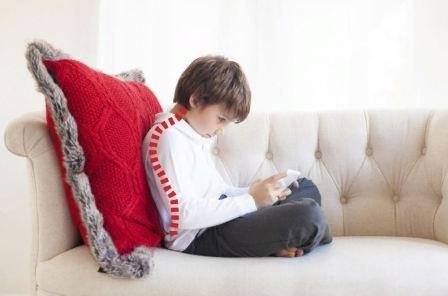
Muscle spasm
As a rule, neck pain in a child is caused by tense muscles. High stress on the cervical spine causes the muscles in the neck to tighten, which can lead to chronic pain.
A spasm occurs if the child has been in the same position or in a draft for a long time. Usually occurs in the morning after sleep on one side of the neck.
Thus, complaints of a tense neck indicate excessive strain, poor posture, lack of movement, or weak neck muscles. In many cases, there is a combination of several factors. But the painful condition is highly treatable.
Injury
This category includes bruises - falling from a bicycle, skateboard, tree or swing, blows of varying strength during outdoor games, or sharp and incorrect turns to the side.
Inflammation of the meninges
Severe pain, high temperature (38-39°C) and causeless fatigue, neck pain in a child indicate inflammation of the meninges (meningitis). The most important sign of meningitis is a small blistering rash.
In addition, there are severe headaches and fainting. Despite some signs, the presence of meningitis can only be determined using a lumbar puncture.
Attention! Inflammation of the meninges can be caused by both viruses and bacteria. While viral meningitis usually resolves without sequelae, a bacterial infection can lead to serious complications.
Curvature of the neck - torticollis
A painful condition when the child's head is constantly in an inclined position. Constantly present pain makes it difficult to hold your head up normally. Torticollis can be either congenital or acquired.
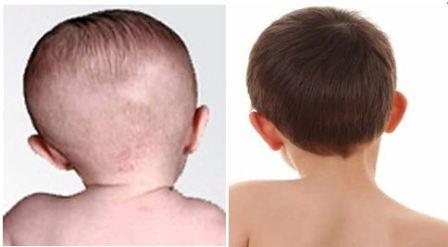
In this condition, the muscles on one side of the neck are constantly in a tense state, while stretching and lengthening. Treatment must be carried out before the age of 10, otherwise the face will acquire asymmetrical features.
Inflammation of the lymph nodes
It manifests itself as a sudden lumbago in the vertebra, ear or sore throat. Body temperature rises. When the lymph nodes are inflamed, their pronounced protrusion is considered a clear sign.
Stress
In addition to poor posture and weak muscles, anxiety and stress also cause neck pain in a child. In moments of psychological stress, he automatically shrinks unnaturally, stretches his shoulders, sharply puts his head on the back of his head or bends it forward.
If anxiety and stress occur frequently, the neck muscles do not have time to recover and relax.
Symptom of serious diseases
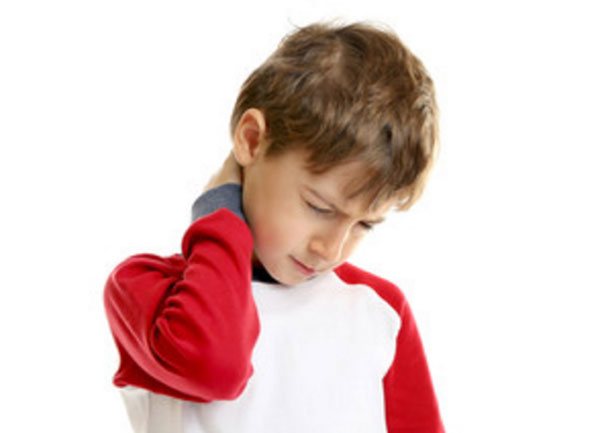
Nuchal pain along with pain in the back of the neck can be caused by meningitis
Along with more or less harmless causes of pain, there may be pathologies that require immediate medical attention, and some require emergency care.
- Meningitis. With this disease, the back of the child’s neck hurts, the presence of severe pain in the head, high fever are typical, the baby may vomit, and fainting is possible. The disease requires an emergency call to the ambulance, as it is fraught with serious complications; advanced conditions often result in death.
- Osteochondrosis. Painful sensations radiate to the back, and are also felt in the joints and ligaments - a sign of a violation of the integrity of the intervertebral discs. The child has cervical osteochondrosis. This disease can be fraught with displacement or compression of nerves and blood vessels, and impaired blood circulation in the brain. In childhood, this pathology is rarely diagnosed, but it does occur. Therefore, at the slightest suspicion, you should consult a doctor for a full examination and begin treatment of the disease at an early stage.
- Intervertebral hernia. More common in adults. Pain in the neck is projected into the arm, particularly the shoulder. It is especially noticeable when turning and tilting the head. There may also be back pain, numbness in the hand, and tingling in the fingers. If the child does not start treatment during the course of treatment, the blood supply to the brain will be disrupted and the soft tissues located in the area of the hernia will become inflamed. These manifestations in rare cases are symptoms of an even more serious pathology - a tumor in muscle tissue or on the spinal cord, which certainly requires even faster diagnosis and therapy.
- The neck hurts on the side due to muscle spasm. The muscle fibers on this side are tense, which can be felt upon palpation, have increased sensitivity, the baby practically cannot turn his neck, and experiences sharp pain. The cause of the spasm may be incorrect posture when sitting or sleeping, or a consequence of a draft.
- Myositis. This disease is an inflammation of the neck muscles. A sharp pain in the neck is felt, which intensifies when turning the head or palpating the neck. Painful sensations radiate to the temples, shoulders, ears. Characterized by the presence of chills, high temperature, and general weakness. The inflammatory process develops as a result of hypothermia in cold water or a draft, and can also be a consequence of being in an incorrect position for a long time. This disease is dangerous because it can spread to nearby muscles, which can cause problems with swallowing, coughing, and breathing problems.
- Torticollis. The child feels pain on the side of the neck, the muscles in this area are tense. The baby is unable to hold his head. The facial muscles, which are located on the opposite side of pain, are in constant tension. Parents should understand that if left untreated, the baby will develop facial asymmetry, and if treated in a timely manner, the baby will be relieved of a stiff neck.
- Inflammatory process in the sterno-clavicular muscle. It is formed after birth trauma, when the neck muscles are clamped. Pain is observed at the slightest attempt to turn the head to the side and upon palpation of the inflamed area.
- In rare cases, rheumatoid arthritis can cause neck pain in a baby. Characterized by inflammation of the joints, weakness, and a possible rise in temperature.
- Inflammation of the lymph nodes. Characterized by the presence of pain on one side. In this case, an enlarged lymph node can be clearly felt in the painful area - it can be the size of a pea or larger, painful on palpation. The baby will complain of feeling unwell, sudden weakness, chills, and the temperature may rise. This ailment can be either an independent disease or a sign of another disease in which the child’s neck hurts in the front:
- bacterial sore throat;
- allergies;
- rubella;
- fungal infection.
Neck pain can be a complication of sore throat, pneumonia or polio.
How to provide first aid to a child
Undoubtedly, the first thing to do is to go to a hospital for treatment, but if this is not possible, then measures should be taken to suppress pain and inflammation.
Important! First aid is provided in all cases except inflammation of the meninges (meningitis).
Muscle release helps relieve discomfort in the neck: a light massage with completely relaxed muscles.
In difficult cases, give an anesthetic in the form of:
- Suspensions – Nurofen, Panadol,
- Tablets – ibuprofen, analgin,
- Powder - nimil.
Make rubbings - menovazin, camphor oil.
Pain syndrome as a result of injury
Active children can hit themselves, pull muscles and not notice it at first. You can get a minor injury during training or during outdoor games. Unpleasant sensations may occur after falls or blows. In this case, the child usually has pain in the neck on one side or in the back. No treatment is required, everything will go away on its own. The main thing is to limit physical activity during this period and ask the child not to make sudden movements. However, if the child complains of pain for several days, it is necessary to immediately show him to the doctor.
What activities will help relieve neck pain in a child?
It is possible to relieve painful sensations at home, but this is not a panacea and only applies to non-critical cases.
The basic rule is not to heat or cool the problem area without knowing the exact cause of the pain.
- Warm baths will help relieve muscle tension and pain.
- The pain is relieved by gentle stretching of the neck throughout the day.
- Muscle tension will be relieved by periodically lying down - 15-20 minutes on your back on a flat plane, or on the floor.
- Warm up daily, trying to touch your chin and ear to each shoulder.
- Slowly move your head left and right, forward and backward, each time resting the palm of your hand in the opposite direction.
To sleep, you need to choose a small flat pillow.
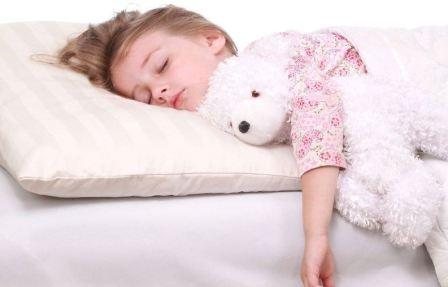
The underlying causes of pain in the neck area
There are a number of reasons why a child may experience pain in the neck area. These reasons are:
- Muscle spasms. Often in children, neck pain occurs due to muscle spasms. In this case, the symptom can occur not only during the day, but also at night when the child is sleeping. Often the main cause of muscle spasm is blowing in a draft.
- Inflammatory processes in the lymph nodes. Many people believe that inflammation of the lymph nodes is not dangerous, although this phenomenon hides the first signs of the development of meningitis.
- Meningitis. A dangerous disease that often occurs among children under 5 years of age. With such a dangerous disease, the child develops symptoms of increased body temperature, as well as pain in the head and neck area. With complicated meningitis, a rash appears on the skin, which looks like small pimples.
- Torticollis. Neck pain can occur due to a disease such as torticollis. This disease can be identified by its characteristic symptoms, when the child holds his head in only one position. With torticollis, in rare cases, an increase in temperature is observed, which is most likely associated with the acquisition of infectious diseases.
- Inflammation of the cleidomastoid muscle. Muscle tightening is observed during the birth process, resulting in serious injury to the baby. When this muscle is inflamed, the child can turn his head only in one direction.
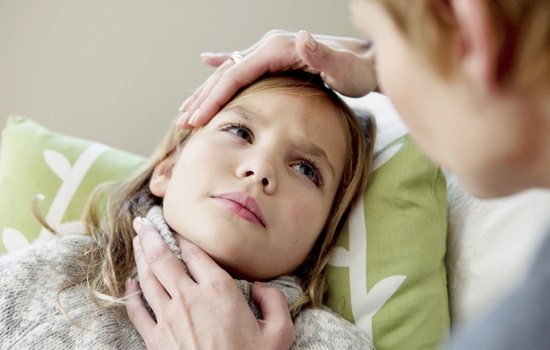
If neck pain is not associated with the above reasons, then perhaps such symptoms are a consequence of such actions or diseases:
- frequent experiences and stress in a child, which occurs over the age of 7 years;
- adverse symptoms after using medications;
- complications after a sore throat;
- tumors and intracranial diseases.
To find out for yourself the causes of neck pain in a child, you should analyze the entire picture of symptoms. If it is not possible to determine the causes of the development of such a pathology, you need to consult a doctor.
It is important to know! It is strictly prohibited to smear a child’s neck without a correct diagnosis.
Comprehensive treatment of neck pain in children
Ligaments and muscles that have been sprained must be returned to their normal state.
1) If a child has neck pain due to pulled muscles, a collar splint is used - it will help reduce the severity in the spinal-cervical region during treatment.
2) Anti-inflammatory non-steroidal drugs are used in the form of ointments:
- Dolobene,
- Ibuprofen,
- Apizartron,
- Traumeel,
- Fanigan.
Severe pain will be removed:
- Ketorol,
- Spasmalgon,
- Tempalgin.
These drugs can only be used in accordance with the instructions.
Gels with menthol, bee and snake venom, and camphor are also used. These products warm, causing inflammation to go away and blood supply to be restored. Pain impulses will be blocked, and the nerve endings of the neck will no longer succumb to internal irritations.
3) Treatment of severe cases is carried out with special injections, which are prescribed by the doctor - analgesics (meloxicam), muscle relaxants (mydocalm) and B vitamins (milgamma).
4) After removing the collar splint and painful symptoms, special physical therapy is applied.
5) The doctor may prescribe reflexology, physiotherapy and massage. You can contact an osteopath or massage therapist.
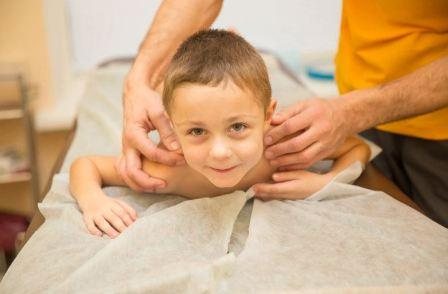
Why does my neck hurt on one side?
Pain in the cervical muscles can develop due to many factors.
If a child has a neck pain when turning his head, the most likely causes of the discomfort should be excluded. Here they are:
- incorrect posture, lack of motor activity. A sedentary lifestyle or lack of physical activity provokes the development of curvature of the spinal column, which leads to pain.
- An incorrectly selected mattress or pillow for a child often causes pain in the back of the head after waking up. The malaise is pulsating in nature.
- Minor damage. Minor neck injuries (bruises, blows, etc.) can also provoke pain.
- Systematic stress, emotional pressure, worries.
- Regular physical overexertion. An overly heavy briefcase can cause aching pain in the child's neck and shoulders.
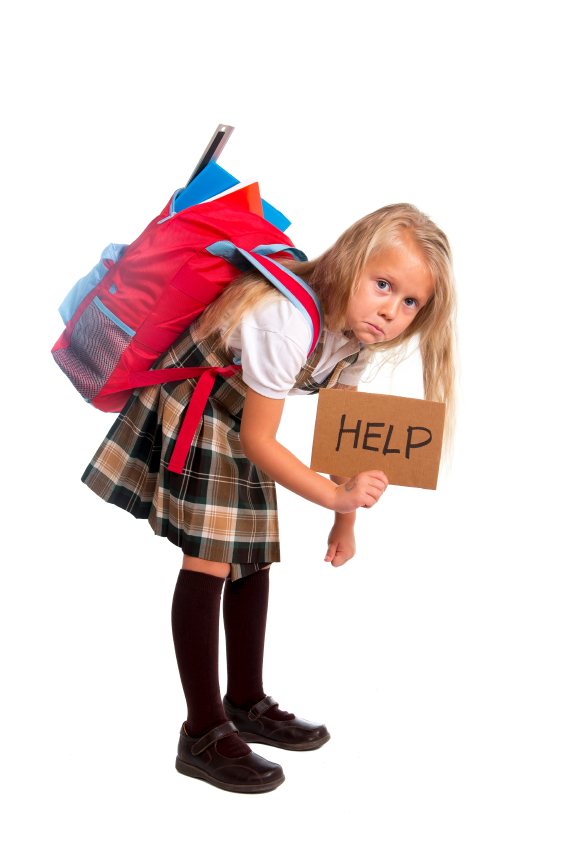
Pain in the back of the neck is a sign of the following pathologies of muscle tissue and the spinal column:
- inflammation of the joints (rheumatoid arthritis). Primary schoolchildren and children of kindergarten age are susceptible to the disease. The disease is accompanied by pain in the neck and joints, constant fatigue, and high fever. There is excessive sweating, enlarged lymph nodes, and sometimes skin rashes. The pathology can become chronic.
- Torticollis (in other words, torticollis). This is the name for deformation of the cervical spine, which affects babies from birth. Visually, the pathology is determined by asymmetry and tension of the facial muscles on one side (at the place of their tension and stretching). The child suffers from pain, and his head is constantly tilted. If treatment is not started in a timely manner, deformation of the patient's skull is possible. In the future, torticollis becomes the cause of the development of scoliosis.
- Deformation, curvature of the spinal column. One of the most common causes of pain. It occurs as a result of muscle weakness (hypodynamia), incorrect posture, etc. Even an incorrect position of the child during sleep can provoke curvature of the ridge.
- Myositis. The inflammatory process in the muscles of the cervical region is accompanied not only by pain. The child complains of increased body temperature, general weakness and fatigue, and chills.
Sometimes the cause of pain in the cervical spine is the development of an infectious pathology. The most common ailments are:
- osteomyelitis (inflammation of bone tissue).
- Poliomyelitis (a contagious disease of the central nervous system).
- Inflammation of the lungs (pneumonia).
- Meningitis.
The last option is considered the most dangerous, since during this pathology inflammation of the lining of the brain occurs. The main risk group for this disease is children under 5 years of age.
The urgency of the condition is determined by the presence of the following clinical picture:
- nausea and vomiting.
- Headache.
- Significant increase in temperature.
- Seizure state.
- Photophobia.
- Fainting.
- Protrusion of the fontanel in infants.
- Muscle tension in the thoracic region.
Please note: lack of timely treatment is usually fatal.
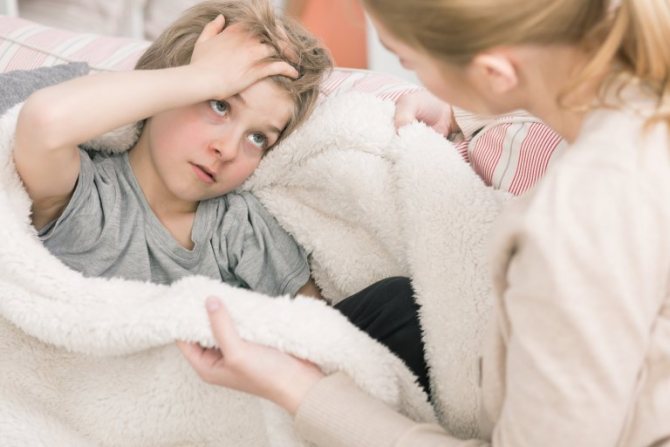
Common causes of pain in the neck on the left side include lymphadenitis. Inflammation and, as a result, enlargement of the lymph nodes is usually observed during one of the infectious pathologies:
- flu.
- Smallpox.
- Bacterial sore throat.
- Etc.
The disease is accompanied by the following symptoms of intoxication:
- Severe increase in body temperature (up to 40 degrees).
- Sore throat.
- Chills.
- Weakness, fatigue.
- Sleep problems.
- Lack of interest in food.
- Headache.
Even vaccinations, caries, and weakened immunity can provoke inflammation of the lymph nodes.
Treatment of pain with folk remedies
If a child has a neck pain, it is contraindicated to prescribe medication on your own, but proven traditional medicine will help out in a situation without significant complications. They can also be used in conjunction with the main treatment regimen.
Important! Before using folk remedies, you need to make sure that the child is not allergic to one or another component.
Sauerkraut and raw potatoes
2 large potatoes are grated on a fine grater to make a paste. Mix with cabbage in equal quantities (1:1). Place the mixture on gauze and apply to the sore spot, covered with plain cellophane, for 30 minutes, 2 times a day.
Horsetail and lard
Grind 200 g of lard, and grind dry horsetail (50 g) into pollen. Mix everything until smooth and leave in a cool place. Before use, warm the ointment in your hands. It is applied to painful points 3 times a day.
Chamomile ointment
Chamomile ointment does not last long, so you don’t need to do much. The calculation is based on four times a day. Chamomile is turned into powder (both fresh and dry). Then mix butter (4 tbsp) and chamomile powder (1 tbsp). Rub on painful areas.
Cabbage, soda and soap
A couple of cabbage leaves are rubbed with laundry soap and sprinkled with baking soda (2 tsp). They are applied to each other with the smeared side, and the clean side is applied to the neck. Everything is wrapped with a scarf on top. The compress remains on all night.
To prevent neck pain in a child from becoming constant, or even better, from not occurring at all, it is necessary to take preventive measures. It is necessary to take breaks during lessons at the table, exercise regularly, and avoid wind and drafts.
Which doctor should I consult for neck pain?
Pain in the neck area in a child is often a symptom of many diseases. The clinical picture of the disease is extensive:
- heaviness in the head.
- Constant weakness, feeling tired.
- Numb hands.
- Shooting pain in the vertebrae.
- Etc.
Sometimes parents do not know what to do if their child has neck pain on one side. If you notice the above symptoms, you should immediately contact a competent pediatrician. Based on the examination, the doctor will refer the patient to more specialized specialists to perform the necessary diagnostics. Please note: self-medication for neck pain is extremely dangerous as it can lead to serious consequences.
Osteochondrosis
Premature aging of the spine, in which degenerative processes develop, most often occurs in adults. However, recently doctors have also diagnosed children under the age of 16 with “osteochondrosis”.
The main cause of childhood osteochondrosis is a delay in the development of connective tissue, which may be caused by heredity or a violation of mineral metabolism at a young age.
If a child has pain in the back of the neck and symptoms such as headache, tinnitus, and spots flashing before the eyes are observed, then osteochondrosis of the cervical spine can be assumed. What to do in this case? With timely diagnosis and compliance with all medical recommendations, osteochondrosis in children is completely curable. Therefore, the sooner the parents show the child to the doctor, the higher his chances of recovery.
We advise you to read: Treatment of inflammation of the neck muscles
Treatment methods for osteochondrosis are:
- Taking chondroprotective drugs that contain glucosamine and chondroitin. These elements are the building material for intervertebral discs.
- Physiotherapy. Procedures such as magnetic therapy, electro- and phonophoresis, and UHF will help relieve inflammation, eliminate pain and tension in the neck muscles.
- Acupuncture is one of the most effective and safe methods of treating osteochondrosis.
- Physiotherapy. Performing exercises selected individually helps strengthen the muscle corset and improve the health of the spine.
- Massage.
Provoking factors
So, let's find out why a child may experience neck pain on only one side?
There are quite a few reasons that provoke this phenomenon. Here are the most common ones:
- Incorrect posture of the child. If your baby's neck hurts every time he tilts his head, it may be due to a sedentary lifestyle. In this case, pain in the neck can occur only on one side, most often on the left. Also, curvature of posture may be associated with the child’s reluctance to perform physical exercises in physical education lessons.
- Incorrectly selected pillow and mattress. In this case, the baby will feel a dull aching pain in the neck every time he wakes up. What to do in this case? There is no need to treat the pain syndrome that arises for this reason, because the baby’s discomfort will go away after his parents select a suitable sleeping set for him. It is recommended to give preference to an orthopedic mattress and an orthopedic pillow.
- Minor injuries. During children's games, many kids get injured. Why is this happening? It's all about the large amount of children's energy that they throw out while playing. For example, a small hematoma may appear on the child’s neck due to a bruise. Parents should not sound the alarm if the baby’s neck does not hurt after an injury. Pain on the left side of the neck may occur due to a fall on the left side.
- Wearing a heavy backpack. When a child carries a heavy load, the muscles in his neck and back become very tense. And, since children’s muscles have not yet fully strengthened, their neck can be very sore after such stress. In this area, the child may feel discomfort of a pulling and aching nature.
- Muscle spasm. If a child's neck pain is caused by a muscle spasm, he will feel prolonged discomfort on only one side. In this area, his muscles will be tense and especially sensitive. What can cause muscle spasm? It is provoked by drafts, overexertion and excessive physical activity. If a child sits at the computer for a long time, he may experience muscle spasms.
- Inflammation of the lymph nodes. With such inflammation, the child feels severe pain in the neck. This disease is also characterized by thickening of the skin in the area of the lymph nodes. As a result, the baby's neck becomes wider. If his cervical nodes are inflamed, there will be complaints of shooting pain in the neck and back. It is worth noting that discomfort will only be felt on the side where the lymph node is inflamed. This process is also characterized by a sore throat. The baby's body temperature may rise. In some cases, surgeons remove the inflamed lymph nodes.
- Rheumatoid arthritis. Previously, it was believed that only older people were susceptible to this disease. However, even young children can exhibit symptoms. With rheumatoid arthritis, the child has severe neck pain. This disease is also accompanied by symptoms such as fever, joint inflammation, drowsiness and malaise. What to do to improve the child’s well-being? If rheumatoid arthritis causes discomfort, you should consult a doctor. Perhaps he will prescribe medications for the baby that can help eliminate pain in the neck and other parts of the body.
- Crooked neck. With this anatomical pathology, the baby’s head is always in an inclined position, and it hurts a lot. A child with this pathology only has pain on one side of the neck. This is due to tension in certain neck muscles, which occurs due to tilting the head. With this disease, the facial muscles on the other, painless side lengthen. Consequently, this pathology is accompanied by facial asymmetry.
Until the age of 10, torticollis in a child can be cured. If you don't do this, facial asymmetry will be difficult to correct.
In rare cases, this disease can occur as a side effect from taking certain medications.
Also, a child may experience cervical discomfort due to pathological processes in the spine, for example, due to improper development of the vertebrae.
As for diseases that could provoke the manifestation of this symptom in a child, it is difficult to single out anything specific.
Rather, cervical discomfort occurs as one of the complications of certain diseases.
What diseases are we talking about?
- Chicken pox.
- Angina.
- Cerebral paralysis.
- Polio.
- Some viral diseases, including influenza.
- Pneumonia, etc.
It is impossible not to mention such a factor in the occurrence of cervical discomfort in a child as psycho-emotional stress.
When a baby is depressed for a long time, a stress hormone enters his blood, which contributes to the occurrence of pain in any part of the body, including the neck.
To improve the well-being of a stressed baby, you need to calm him down and switch to positive energy.
You can do this with interesting games, a relaxing massage or a walk in the fresh air.
Common reasons
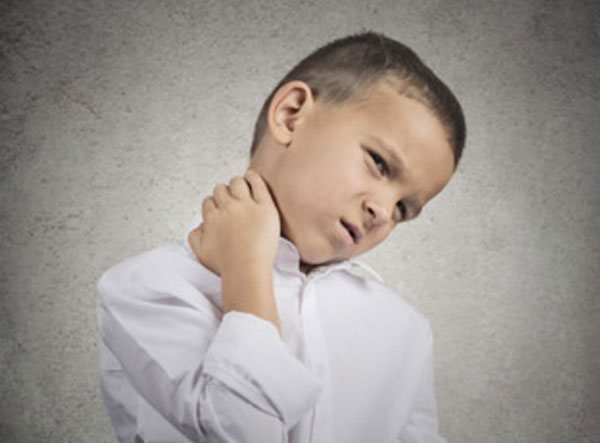
Every parent should know what factors can influence the occurrence of neck pain in a child. So, the most common reasons that do not pose a particular danger to the baby’s health include:
- a consequence of carrying heavy objects, in particular backpacks, pain is the result of overstrain of the neck and shoulder muscles;
- in a physically active toddler, this may occur due to muscle strain during training, often such pain is present only on one side;
- the result of a fall from a swing or horizontal bar, the condition often normalizes with limited physical activity;
- sedentary lifestyle, lack of sufficient physical activity;
- an uncomfortable pillow or mattress can cause throbbing pain in the back of the head, radiating to the neck;
- the presence of incorrect posture, the development of the first degree of scoliosis - is increasingly observed in modern children who spend a lot of time in front of a monitor screen;
- side effects of taking certain medications;
- In adolescents, a common cause of pain in the neck is nervous tension and stress; bursting and/or throbbing pain in the head and neck is typical.
